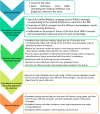Harmonization process for the identification of medical events in eight European healthcare databases: the experience from the EU-ADR project
- PMID: 22955495
- PMCID: PMC3555316
- DOI: 10.1136/amiajnl-2012-000933
Harmonization process for the identification of medical events in eight European healthcare databases: the experience from the EU-ADR project
Abstract
Objective: Data from electronic healthcare records (EHR) can be used to monitor drug safety, but in order to compare and pool data from different EHR databases, the extraction of potential adverse events must be harmonized. In this paper, we describe the procedure used for harmonizing the extraction from eight European EHR databases of five events of interest deemed to be important in pharmacovigilance: acute myocardial infarction (AMI); acute renal failure (ARF); anaphylactic shock (AS); bullous eruption (BE); and rhabdomyolysis (RHABD).
Design: The participating databases comprise general practitioners' medical records and claims for hospitalization and other healthcare services. Clinical information is collected using four different disease terminologies and free text in two different languages. The Unified Medical Language System was used to identify concepts and corresponding codes in each terminology. A common database model was used to share and pool data and verify the semantic basis of the event extraction queries. Feedback from the database holders was obtained at various stages to refine the extraction queries.
Measurements: Standardized and age specific incidence rates (IRs) were calculated to facilitate benchmarking and harmonization of event data extraction across the databases. This was an iterative process.
Results: The study population comprised overall 19 647 445 individuals with a follow-up of 59 929 690 person-years (PYs). Age adjusted IRs for the five events of interest across the databases were as follows: (1) AMI: 60-148/100 000 PYs; (2) ARF: 3-49/100 000 PYs; (3) AS: 2-12/100 000 PYs; (4) BE: 2-17/100 000 PYs; and (5) RHABD: 0.1-8/100 000 PYs.
Conclusions: The iterative harmonization process enabled a more homogeneous identification of events across differently structured databases using different coding based algorithms. This workflow can facilitate transparent and reproducible event extractions and understanding of differences between databases.
Figures


Similar articles
-
A semantic approach for the homogeneous identification of events in eight patient databases: a contribution to the European eu-ADR project.Stud Health Technol Inform. 2009;150:190-4. Stud Health Technol Inform. 2009. PMID: 19745295
-
EU-ADR healthcare database network vs. spontaneous reporting system database: preliminary comparison of signal detection.Stud Health Technol Inform. 2011;166:25-30. Stud Health Technol Inform. 2011. PMID: 21685607
-
The role of electronic healthcare record databases in paediatric drug safety surveillance: a retrospective cohort study.Br J Clin Pharmacol. 2015 Aug;80(2):304-14. doi: 10.1111/bcp.12610. Epub 2015 May 20. Br J Clin Pharmacol. 2015. PMID: 25683723 Free PMC article.
-
Combining multiple healthcare databases for postmarketing drug and vaccine safety surveillance: why and how?J Intern Med. 2014 Jun;275(6):551-61. doi: 10.1111/joim.12159. J Intern Med. 2014. PMID: 24635221 Review.
-
Using real-world healthcare data for pharmacovigilance signal detection - the experience of the EU-ADR project.Expert Rev Clin Pharmacol. 2015 Jan;8(1):95-102. doi: 10.1586/17512433.2015.992878. Expert Rev Clin Pharmacol. 2015. PMID: 25487079 Review.
Cited by
-
Factors influencing harmonized health data collection, sharing and linkage in Denmark and Switzerland: A systematic review.PLoS One. 2019 Dec 12;14(12):e0226015. doi: 10.1371/journal.pone.0226015. eCollection 2019. PLoS One. 2019. PMID: 31830124 Free PMC article.
-
Combining clinical and genomics queries using i2b2 - Three methods.PLoS One. 2017 Apr 7;12(4):e0172187. doi: 10.1371/journal.pone.0172187. eCollection 2017. PLoS One. 2017. PMID: 28388645 Free PMC article.
-
Real-world data reveal a diagnostic gap in non-alcoholic fatty liver disease.BMC Med. 2018 Aug 13;16(1):130. doi: 10.1186/s12916-018-1103-x. BMC Med. 2018. PMID: 30099968 Free PMC article.
-
Using and improving distributed data networks to generate actionable evidence: the case of real-world outcomes in the Food and Drug Administration's Sentinel system.J Am Med Inform Assoc. 2020 May 1;27(5):793-797. doi: 10.1093/jamia/ocaa028. J Am Med Inform Assoc. 2020. PMID: 32279080 Free PMC article.
-
Clinical Research Informatics for Big Data and Precision Medicine.Yearb Med Inform. 2016 Nov 10;(1):211-218. doi: 10.15265/IY-2016-019. Yearb Med Inform. 2016. PMID: 27830253 Free PMC article.
References
-
- Lindquist M. VigiBase, the WHO global ICSR database system: basic facts. Drug Inf J 2008;42:409–419.
-
- Begaud B, Martin K, Haramburu F, et al. Rates of spontaneous reporting of adverse drug reactions in France. JAMA 2002;288:1588. - PubMed
Publication types
MeSH terms
LinkOut - more resources
Full Text Sources
Research Materials

